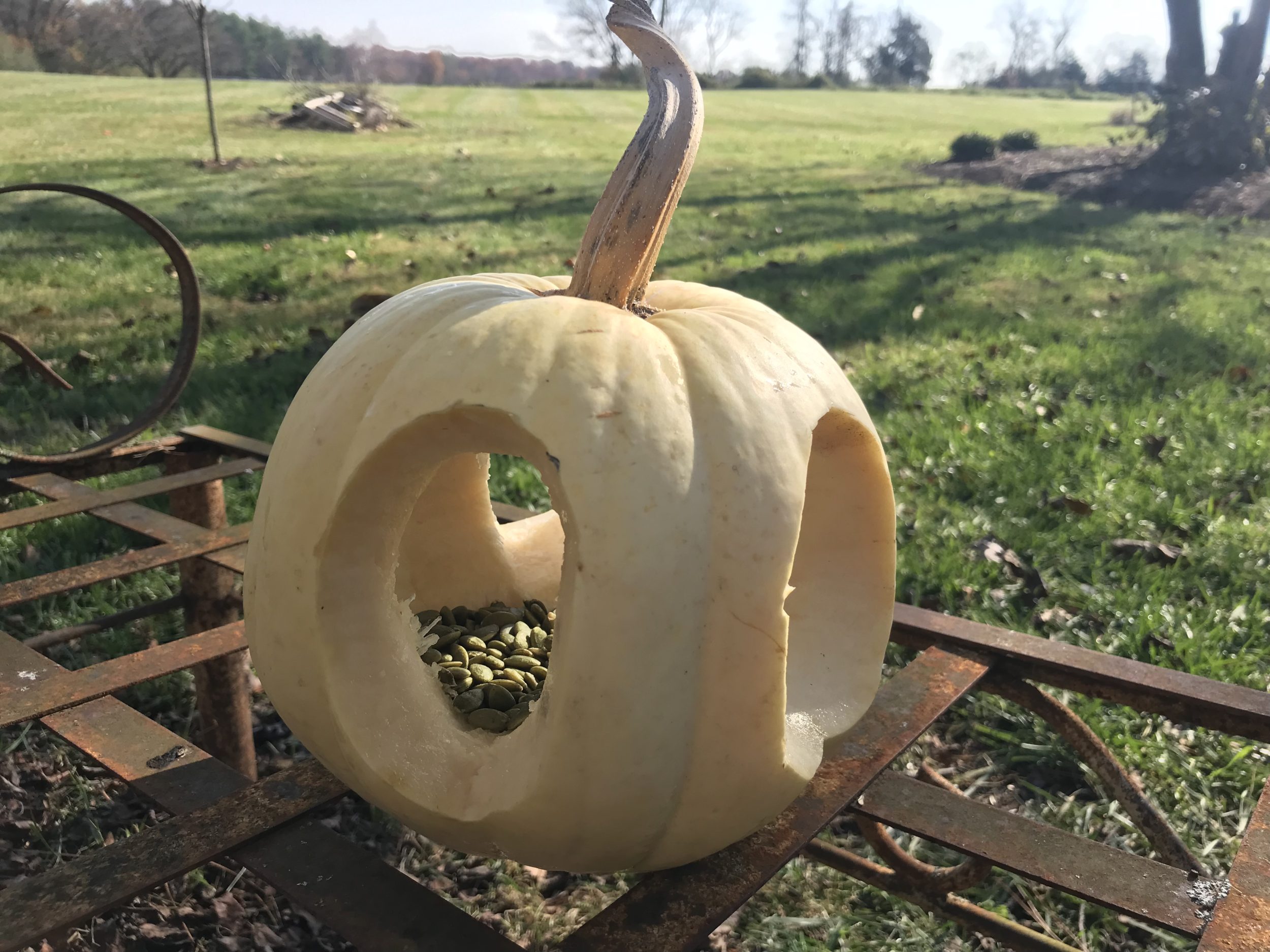The days are getting shorter. The air is brisk. My lawn is an absolute carpet of fallen leaves, a condition from which the turf grass may never fully recover. That must mean that autumn is upon us, that season of death and dread which we all love so much. As we all know, autumn is also the time when all the funny little songbirds bopping around in the trees get hungry as hell. Not because food is in short supply—as I understand it, autumn is "harvest time" precisely because there's food all over the dang place—but because our sweet little bird pals must migrate, do some molting into warm winter togs, and/or store up fat for cold resistance in order to survive the winter. Surely you have already begun your bird-feeding program, so as to avoid being known among birdkind as a huge asshole.
The other thing that happens every autumn at the Palazzo di Thompson, like clockwork, is that several uncarved pumpkins take up residence on my porch and go largely unnoticed, for months, until one day they simply turn into sludge and melt into awful-smelling fuzzy little lakes. Gross! I am a person who likes to carve jack-o'-lanterns, and yet every year I vastly overestimate my capacity for jack-o'-lantern-carving, and every year I wind up scraping two or three abandoned and decomposing pumpkins off my stoop with a snow shovel amid a disgusting cloud of fruit flies. Just a very unpleasant annual ritual.
This year I had four medium-sized white pumpkins sitting on my porch, uncarved, on the morning of November 17. Even in their whole, healthy, unmelted condition, these pumpkins were already a source of anxiety and, yes, shame. They were supposed to have faces, these poor pumpkins. Had they been carved as intended, they already would've putrified and turned grody and been infested by the dreaded fruit flies, and I would've loaded their sagging carcasses into the wheelbarrow and deposited them in the woods. I got rid of the actual jack-o'-lanterns not 48 hours after Halloween. But there is something just completely unpalatable about paying real money for pumpkins and then just one day throwing them into the woods, whole and firm and clean. Better to tell myself they are adding ambiance and curbside appeal to my home, until nature has reduced them to disgusting slime. In this way I am teaching myself a lesson, and that lesson is that I am an idiot piece of shit.
Not this year! This year I decided to combine these seasonal pastimes—having too many pumpkins and feeding my hungry bird pals—into one crafty undertaking. This ingenious project satisfies a bird's natural desire to eat tasty seeds, a homeowner's natural desire to redeem some value from having spent $0.70 per pound on a handful of decorative pumpkins, and a pumpkin's natural desire to be carved by man. I simply turned the pumpkins into bird feeders, and then filled them with seeds (including their own seeds), and set them strategically around my yard, in places where once they start to decompose I will not have to do jack squat, because they will be melting into nature and not onto the steps I use to enter my very home. Already, certain of the more intrepid local songbirds—several kooky nuthatches and the ever-present pairs of chickadees—have started exploring and grabbing at the food. Everyone wins!
You are now asking how you can go about making your very own pumpkin bird feeder. Couldn't be easier! You will need a pumpkin, you will need a sturdy serrated knife for carving, you will need a sturdy metal spoon for scooping, and you will need some bird seed. It's worth noting that the pumpkins need not be leftovers—several of my local grocery stores are selling all kinds of gourds and pumpkins that would work for this. I drew some big ovals on my pumpkins during the planning phase, which required the use of a felt-tip marker, but probably you can just wing it. Simply cut out five or so holes around the outside of your pumpkin, then widen the opening so that you can reach your hand inside, then use your spoon to scoop out the pumpkin guts and smooth the interior. This is important because the more of the really soft gunk you scoop out of there, the longer your pumpkin feeder will last out in the elements.
Another key tip: However large your holes, situate them so that the bottom part of each hole reaches close to the base of the interior of the pumpkin. Songbirds for the most part will not appreciate having to climb all the way inside your feeder to get to the food, although I did have to rescue a moron of a house finch yesterday who'd climbed all the way inside a wood and plastic feeder and then couldn't find his way back out again. By putting the holes so that the bottom of the opening (the perch) is close to the base of the pumpkin, you will allow the birds to land, quickly grab a seed or two, and then bolt back out again, toward safety. Here is a helpful diagram of what this should look like:

I had some leftover pepitas in a bag from a recent cooking project, plus the pumpkins' own seeds, plus a huge box of premixed bird food. I put little handfuls of each into the new pumpkin feeders, and then just set them around the yard. One is on a little bench, under a popular plastic feeder. Another is wedged into a tree. Another is on a fence post. You get the idea.
I figure this arrangement works well for the various birds: The action can get pretty rowdy at the popular feeders, and some of the smaller and more timid birds—goldfinches, titmice, juncos, the very occasional bunting—wind up on the periphery, waiting for the cardinals and house finches to take a break. These little temporary feeders will spread everything out, without sticking around long enough to attract whole new communities of squirrels, which is always a concern when you set up new feeding stations.
These pumpkins will for sure decompose and melt, but in the meantime they get to have a useful little job in what I guess we will call the hyperlocal ecosystem. Instead of triggering a whole gruesome wave of self-loathing and featuring prominently in the onset of seasonal affective disorder, they will cause me to feel like a brilliant craftsperson, and reaffirm my status as Lord of the Songbirds. Genius.






